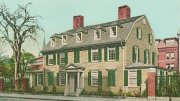Anyone who follows elections in her local community is familiar with the passionate debate about public-school spending. How much funding do the schools need? What is the most effective use of those funds? Studies conducted from 2015 on have found that when communities increase spending on local schools, student test scores, graduation rates, and graduates’ future wages and economic mobility all rise—confirming popular intuitions. Research by economist Peter Blair, assistant professor in the Graduate School of Education, now offers fresh insights into which types of school spending matter most to families—and provides a way for communities to measure whether such spending is at optimal levels.
Blair and his colleagues Patrick Bayer, of Duke University, and Kenneth Whaley, of the University of Houston, found a way to illuminate these questions by analyzing house prices. Local public-school spending, prior studies have shown, is positively capitalized into house prices, meaning that families are willing to “vote with their feet” and spend more for homes in school districts that invest more in education. At the same time, property taxes are negatively capitalized in house prices: If school spending is held constant, the more property taxes rise, the more house prices fall.
Given that debates about school funding tend to be fiercely partisan, Blair says he was deliberate in choosing to study education through the prism of house prices, which he sees as neutral territory. “There’s broad agreement,” he says. “Everyone, regardless of political affiliation, cares about house prices.”
He and his colleagues examined house-price data from the Federal Housing Finance Agency together with school-finance data from the National Center for Education Statistics, which included teacher salaries, capital and construction expenses, and student demographics. The researchers also focused on schools in states with court-mandated finance reforms enacted between 1990 and 2015. These reforms used block grants or changes in property taxes to equalize per-pupil spending across school districts. This provided a useful sample of districts that enabled Blair and his colleagues to compare the effects of different amounts and types of funding, as well as the impacts of altered property-tax laws, and to establish precisely what caused house prices to change.
Their statistical analysis revealed that every 1 percent increase in a school district’s spending increased local house prices by .95 percent. More significantly, every 1 percent spent on teacher salaries increased house prices by 2 percent. Blair was startled by the size of this effect. “School spending on teachers is what matters the most for house prices, just far and away,” he explains. By comparison, spending on infrastructure seems not to have as big an impact: new or upgraded facilities appear to matter less to homebuyers—but “this is not to say that if you’re in a school district where the schools are falling apart, you shouldn’t spend more on that,” Blair adds. “This just signposts the fact that on average, the place where we need an injection of resources is spending on teachers.”
This finding led to the researchers’ next question: across the nation, is the spending on teachers efficient? Blair says economists have wrestled for more than 80 years with the question of whether spending on public goods (from public schools to street lights) can be provided efficiently or at optimal levels—meaning that residents pay what taxes they’re willing to tolerate to receive the services they want. This may be why non-salary spending, say on capital projects such as a new athletics stadium, does not provide the same boost to house prices: such spending matters less to residents. In fact, capital projects are often funded by bonds, which raise future property taxes, and are thus likely to cause home prices to drop.
Blair and his colleagues found that among communities with a tax-funded increase in teacher pay, a subsequent lift in house prices signaled that spending on teachers had been inefficiently low. “Households were willing to have higher taxes to have better-funded schools,” he explains. The spending on teachers can take various forms—recruiting more experienced educators, say, or expanding the number of faculty members, thus reducing student-to-teacher ratios—but the new research demonstrates that these measures are efficient, Blair says: “There’s evidence in the paper that both of these things result in higher house prices.” Ideally, communities continue raising the amount they spend on a public good until an incremental increase in taxes spent on them has no impact on house prices, he adds. If house prices drop, this may indicate that homeowners don’t value the increased local expenditures.
Blair believes this research offers policymakers a new tool to make the case for investing more in public education—especially educator pay. “It’s the kind of policy that households want,” he says. “That’s what they’re showing us. They’re choosing to live in places that spend more money on teachers.”









